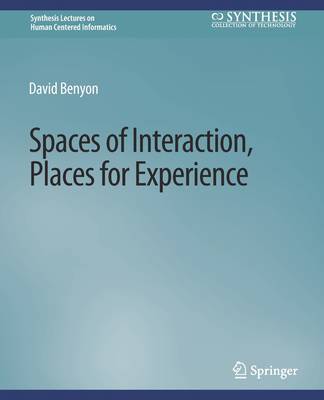
- Retrait gratuit dans votre magasin Club
- 7.000.000 titres dans notre catalogue
- Payer en toute sécurité
- Toujours un magasin près de chez vous
- Retrait gratuit dans votre magasin Club
- 7.000.0000 titres dans notre catalogue
- Payer en toute sécurité
- Toujours un magasin près de chez vous
Description
Spaces of Interaction, Places for Experience is a book about Human-Computer Interaction (HCI), interaction design (ID) and user experience (UX) in the age of ubiquitous computing. The book explores interaction and experience through the different spaces that contribute to interaction until it arrives at an understanding of the rich and complex places for experience that will be the focus of the next period for interaction design. The book begins by looking at the multilayered nature of interaction and UX--not just with new technologies, but with technologies that are embedded in the world. People inhabit a medium, or rather many media, which allow them to extend themselves, physically, mentally, and emotionally in many directions. The medium that people inhabit includes physical and semiotic material that combine to create user experiences. People feel more or less present in these media and more or less engaged with the content of the media. From this understanding of people in media, the book explores some philosophical and practical issues about designing interactions. The book journeys through the design of physical space, digital space, information space, conceptual space and social space. It explores concepts of space and place, digital ecologies, information architecture, conceptual blending and technology spaces at work and in the home. It discusses navigation of spaces and how people explore and find their way through environments. Finally the book arrives at the concept of a blended space where the physical and digital are tightly interwoven and people experience the blended space as a whole. The design of blended spaces needs to be driven by an understanding of the correspondences between the physical and the digital, by an understanding of conceptual blending and by the desire to design at a human scale. There is no doubt that HCI and ID are changing. The design of "microinteractions" remains important, but there is a bigger picture to consider. UX is spread across devices, over time and across physical spaces. The commingling of the physical and the digital in blended spaces leads to new social spaces and new conceptual spaces. UX concerns the navigation of these spaces as much as it concerns the design of buttons and screens for apps. By taking a spatial perspective on interaction, the book provides new insights into the evolving nature of interaction design.
Spécifications
Parties prenantes
- Auteur(s) :
- Editeur:
Contenu
- Nombre de pages :
- 113
- Langue:
- Anglais
- Collection :
Caractéristiques
- EAN:
- 9783031010781
- Date de parution :
- 01-10-14
- Format:
- Livre broché
- Format numérique:
- Trade paperback (VS)
- Dimensions :
- 190 mm x 235 mm
- Poids :
- 240 g

Les avis
Nous publions uniquement les avis qui respectent les conditions requises. Consultez nos conditions pour les avis.






